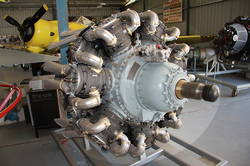Bristol Hercules
 Click on image for larger version
Click on image for larger version
The Bristol Aeroplane Company was formed in 1910 and designed and built a series of military aircraft and aircraft engines pre and post WW1. In 1934 the company designed the first of a series of Hercules aircraft engines that were sleeve valve fourteen cylinder, two row supercharged and air cooled radials that were produced into the late 1950s.
The type was the first of the Company's sleeve valve designs to see widespread use powering many types of military aircraft in mid WW2 including the Bristol Beaufighter and bombers including the Armstrong Whitworth Albermarle, Handley Page Halifax 111 and V11, Vickers Wellington, Short Stirling 111 and the three hundred Avro Lancaster 11s produced. Post war the Hercules powered the Bristol Freighter and other civilian aircraft including the Vickers Viking, Short Solent flying boat, Handley Page Hastings and the French Nord Noratlas.
To produce volumetric efficiency it is necessary to promote optimum intake and exhaust flows by the use of four valves per cylinder, a configuration that was very difficult to engineer on a two or four row cylinder layout and resulted in these conventional type engines being limited to the less efficient two valves per cylinder.
The sleeve valve configuration got around this problem with the sleeve itself being an integral part of the cylinder and providing five ports, three intake and two exhaust.
Bristol's first workable sleeve valve engine appeared in 1934 and initially their engines were basically hand built until a later technique was devised that met the precise tolerances of the sleeve manufacture and permitted mass production of the engines, of which 57,000 + were built.
The Hercules 1 engine produced 1,290hp in 1939, progressing through 1,375hp of the Hercules 11 to 1,650hp of the Hercules V1, and 1,735hp of the Hercules XV11, until the late 1950s when the ultimate of the Hercules series, the Type 734 produced 1,980hp, and powered the Bristol Freighter Mk31.
The Museum's Hercules engine is a Type 734 that powered the Bristol Freighter Mk31 VH-ADL, that is also on display.
The type was the first of the Company's sleeve valve designs to see widespread use powering many types of military aircraft in mid WW2 including the Bristol Beaufighter and bombers including the Armstrong Whitworth Albermarle, Handley Page Halifax 111 and V11, Vickers Wellington, Short Stirling 111 and the three hundred Avro Lancaster 11s produced. Post war the Hercules powered the Bristol Freighter and other civilian aircraft including the Vickers Viking, Short Solent flying boat, Handley Page Hastings and the French Nord Noratlas.
To produce volumetric efficiency it is necessary to promote optimum intake and exhaust flows by the use of four valves per cylinder, a configuration that was very difficult to engineer on a two or four row cylinder layout and resulted in these conventional type engines being limited to the less efficient two valves per cylinder.
The sleeve valve configuration got around this problem with the sleeve itself being an integral part of the cylinder and providing five ports, three intake and two exhaust.
Bristol's first workable sleeve valve engine appeared in 1934 and initially their engines were basically hand built until a later technique was devised that met the precise tolerances of the sleeve manufacture and permitted mass production of the engines, of which 57,000 + were built.
The Hercules 1 engine produced 1,290hp in 1939, progressing through 1,375hp of the Hercules 11 to 1,650hp of the Hercules V1, and 1,735hp of the Hercules XV11, until the late 1950s when the ultimate of the Hercules series, the Type 734 produced 1,980hp, and powered the Bristol Freighter Mk31.
The Museum's Hercules engine is a Type 734 that powered the Bristol Freighter Mk31 VH-ADL, that is also on display.
|
TECHNICAL DATA - Type 734
Cylinders Bore and Stroke Displacement Length Diameter Dry weight Valve system Fuel system Super charger Compression ratio Power output Power to weight ratio |
Two row, 14 cylinder supercharged air cooled sleeve valve engineBore Bore 5.75in (146mm) Stroke 6.5in (165mm) 2,360 cu in (38.7L) 53in (1,346mm) 52in (1,321mm) 2,115ls (959kg) 3 intake and 2 exhaust ports per cylinder Claudel-Hobson carburettor centrifugal, single stage, two speed 7.0/1 1,980hp 0.94hp/lb |
